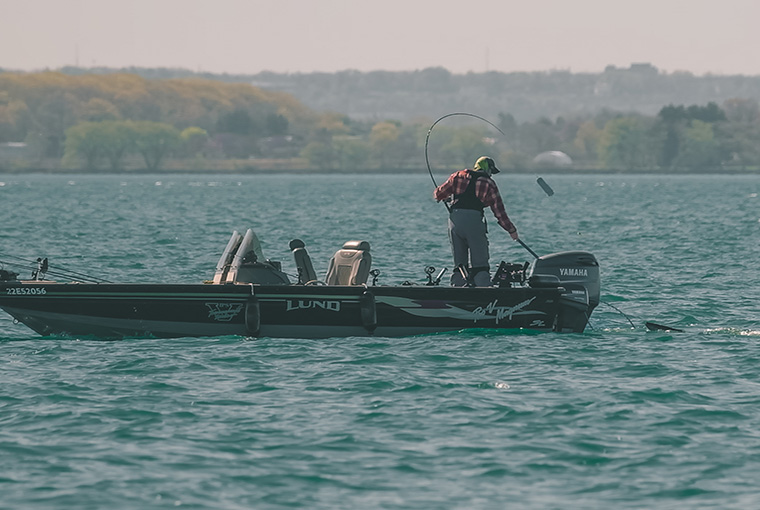
The governments of Canada and the United States, through the Great Lakes Water Quality Agreement, have committed “to protect and restore the water quality and aquatic ecosystem health of the Great Lakes” along with their partners.
To help keep their efforts on track, the Environmental Protection Agency and Environment and Climate Change Canada release an annual assessment on the state of the lakes. Here’s a snapshot of where things stand (as of 2019). Each rating has a current status and trend.
Fish consumption
Fair and unchanging
Over the last 40 years, contaminants including PCB and mercury have declined dramatically. Unrestricted consumption is not yet possible, but general consumption within published guidelines is acceptable. Of note is that Lake Ontario has shown recent consistent improvement.
Drinking water
Good and unchanging
Treated water for consumption is of high quality and well within testing parameters.
Non-native species
Poor and deteriorating
Over 185 aquatic non-native species have produced invasive damage after their introduction. There has been some success with slowing down the rate of new species introductions, the problem tends to be more with existing invaders continuing to establish their range and creating damage. Sea lamprey have been reduced in numbers, but zebra and quagga mussels are creating major negative impacts on nutrient cycling and plankton populations.
Nutrients and algae
Fair and unchanging
Excessive nutrient concentrations can create harmful algae blooms and possible toxins. The western basin of Lake Erie, Hamilton Harbour, and the Bay of Quinte are all affected.
Toxic chemicals
Fair and unchanging
Mercury, PCBs, and PBDEs have decreased significantly from the levels of 40 years ago but have not shown major downward trends in the last 10 years. Concentrations in the offshore water of Lake Ontario and Lake Erie are still a concern but are being monitored closely.
Habitat and species
Fair and unchanging
The indicator includes both coastal and wetland habitat and the offshore aquatic food web. In Lake Ontario and Erie, nutrient enrichment and sedimentation have caused wetland degradation. Regulation of water levels has also severely impaired wetlands. The food web ranges from small plants (phytoplankton) to animals (zoo plankton) and top-end predator fish. Of concern in particular is the health of diporeia, a bottom dwelling, small shrimp-like organism that is a key food source for fish. Severe decline is an issue in all lakes except Lake Superior.
Beaches
Good and unchanging
More than 1,000 beaches are monitored for the bacteria E Coli. Since 2017, Lake Erie beaches have improved, with an increase in the number of safe swimming days.
Groundwater
Fair and undetermined
Concentrations of nitrate from road salt and chloride from agricultural usage are a concern. The process of gathering long-term testing data will provide improved information about trends.
Watershed impacts and climate trends
Fair and unchanging
Forest cover is increasing around Lake Erie but deteriorating in the Lake Ontario area. Global warming has created an increase in precipitation and water levels, a decrease in annual ice cover, and an increase in surface water temperatures.
Lake Superior
Good and unchanging
Toxic chemicals register at much lower levels than the other Great Lakes. Native fish populations are generally in good condition and are supported by a healthy lower food web.
Lake Huron
Fair and unchanging
Fish populations and lower food web organisms in offshore waters have remained low for the last 15 years. In near-shore waters fish populations including walleye have not been so impacted. Quagga mussels are contributing to offshore food web problems.
Lake Ontario
Fair and unchanging
Lake trout populations have risen due to lamprey control but prey fish samplings show some fluctuation. Nutrient issues and unwanted algae blooms are occurring in certain areas.
Lake Erie
Poor and unchanging
Excessive algae blooms are common in the western basin. Despite the decline in prey fish species, Erie supports the largest world class walleye fishery.
“While the overall assessment indicates a Fair and Unchanging report card, a finer lens reveals that environmental stressors and associated interactions still persist. Excess nutrients from intensive agricultural practices, invasive species such as quagga and zebra mussels, and chemicals of emerging concern, including microplastics and pharmaceuticals, threaten fish and wildlife populations, public health, lifestyle benefits, and the economy of the Great Lakes.”
— Adam Weir, OFAH Fisheries Biologist

With more than 40 years of fishing experience, Bob McGary has been an active tournament angler, a Great Lakes guide, and has also helped form a number of youth angling clubs. Reach Bob at: mail@oodmag.com
Originally published in the August 2021 issue of Ontario OUT of DOORS magazine.
